Understanding Autism Masking
Autism masking is a complex and often misunderstood phenomenon that affects many autistic individuals. It involves adopting behaviors and strategies to hide or diminish autistic traits, primarily to navigate social environments more comfortably and avoid stigma. This article explores the multifaceted nature of masking, its manifestation, motivations, impacts, and ways we can support those who mask, ultimately fostering greater understanding and acceptance of neurodiversity.
Defining Autism Masking and Its Core Concepts

What is autism masking and what does it mean?
Autism masking, also known as camouflaging, involves the deliberate or unconscious actions that autistic individuals adopt to hide or reduce visible traits of autism. This behavior aims to help them blend into societal norms and avoid stigmatization or judgment. Masking includes techniques like mimicking socially acceptable gestures, suppressing natural responses such as stimming behaviors, maintaining eye contact even when it feels uncomfortable, scripting parts of conversations, and altering speech patterns.
Many autistic people mask to ensure social acceptance, to prevent negative reactions, or to meet external expectations. Although these strategies can improve daily interactions temporarily, they require significant mental effort and can lead to exhaustion, emotional burnout, and stress. Importantly, masking can shield individuals from immediate social reprimand but can also contain long-term disadvantages.
Synonyms and related terms
Masking is often referred to by various terms, each emphasizing a slightly different aspect:
- Camouflaging: Emphasizes hiding outward signs of autism.
- Social camouflaging: Highlights adapting behaviors in social contexts.
- Passing: Implying the effort to appear neurotypical or indistinguishable from non-autistic individuals.
- Compensatory strategies: Focuses on learned techniques to manage or replace natural responses. These terms, while distinct in nuance, collectively describe the complex behaviors autistic individuals may engage in to navigate their environments.
Conscious and unconscious masking
Masking can happen on both levels. Some individuals are fully aware they are modifying their behaviors—they consciously choose to suppress stimming, force eye contact, or rehearse social scripts. Others may mask automatically or instinctively, having learned over time that certain responses are unacceptable or unwelcome.
This distinction is important because conscious masking can often be controlled or reduced through awareness and support, whereas unconscious masking may be more deeply ingrained and harder to recognize.
Masking as a coping mechanism
For many autistic individuals, masking functions primarily as a coping strategy. Society’s expectations, fear of rejection, or past experiences of discrimination often push individuals to adopt these behaviors. Masking can help them avoid criticism, ridicule, or even abuse.
However, this adaptive approach comes at a cost. The continuous effort to hide true traits can be draining, leading to mental health issues such as anxiety, depression, and burnout. It also hampers authentic social connection because the person’s true self remains concealed.
Despite these drawbacks, masking can offer immediate social benefits, making daily life more manageable and helping to maintain relationships and employment. Recognizing these motivations offers a more compassionate understanding of why many autistic people mask, and highlights the importance of creating inclusive environments that reduce the need for such strategies.
| Aspect | Description | Examples |
|---|---|---|
| What it involves | Suppressing or altering behaviors to conform to societal standards | Hiding stimming, mimicking neurotypical behaviors, scripting conversations |
| Who employs it | Autistic individuals across various ages, especially women and marginalized groups | Women, genderqueer, BIPOC individuals, those facing social pressure |
| Why it occurs | To avoid judgment, stigma, or rejection | Social acceptance, safety, entering work or social spaces |
| Challenges | Emotional exhaustion, delayed diagnosis, mental health issues | Burnout, anxiety, depression |
| Potential benefits | Temporary social acceptance and confidence | Eases social interactions temporarily |
Understanding autism masking involves a broad view of its motivations, manifestations, and impacts. Supporting autistic individuals entails recognizing these behaviors and working toward environments that value authenticity and diversity.
Manifestations and Behaviors of Masking in Practice
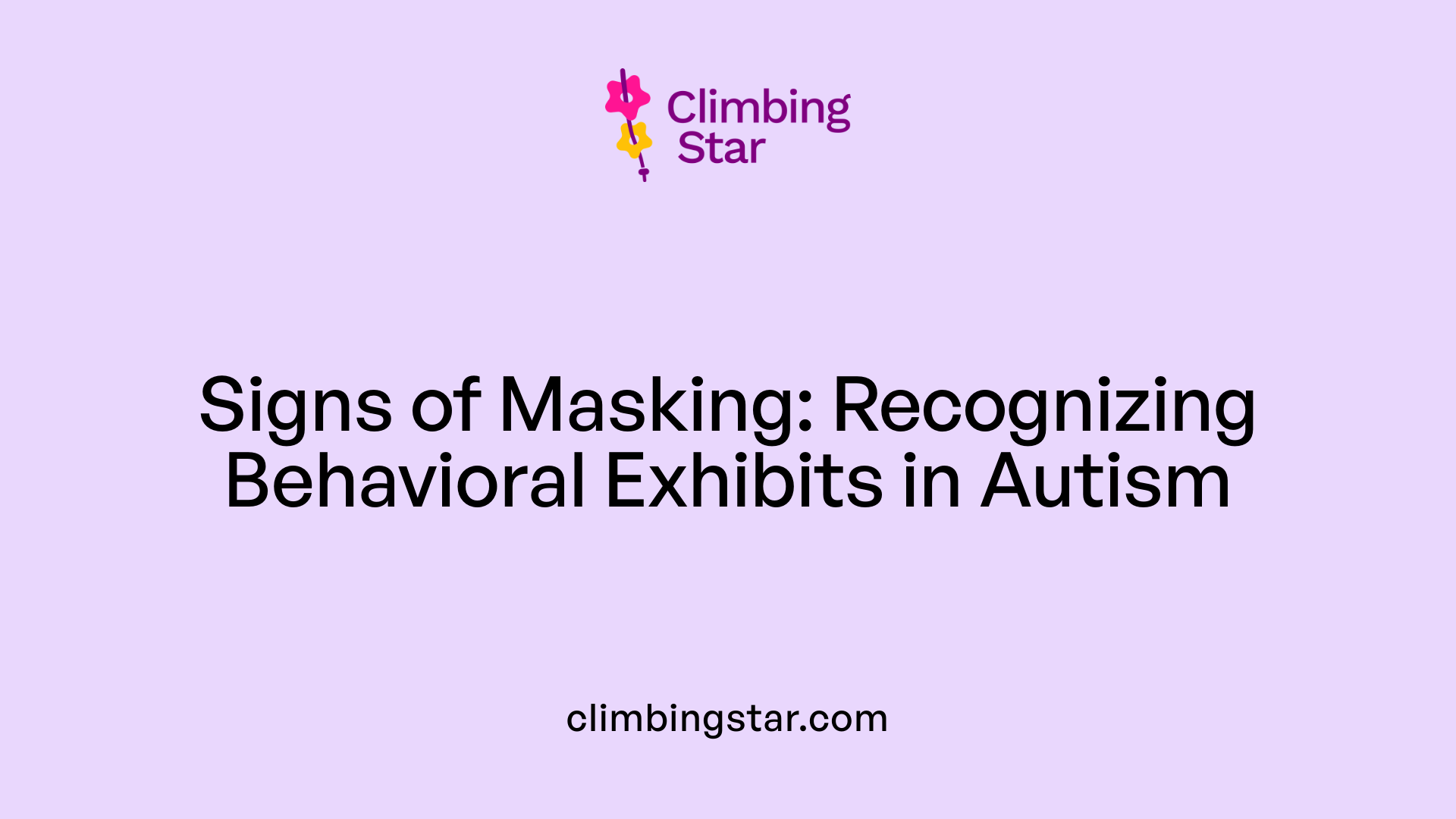
How does autism masking manifest in behavior?
Autism masking often appears through various observable behaviors aimed at blending into social environments. One common manifestation is mimicking social cues and facial expressions. Autistic individuals may imitate the gestures, expressions, and mannerisms of others to appear more typical and socially engaged.
They frequently rehearse scripted conversations or responses, preparing answers in advance for social interactions to avoid awkward silences or unplanned social errors. This rehearsal can be done consciously or unconsciously, especially in unfamiliar or high-pressure situations.
Suppressing or hiding stimming behaviors is another significant aspect of masking. Since stimming (self-stimulatory behaviors) is often misunderstood or viewed negatively, many autistic individuals learn to suppress these actions, which might include hand-flapping, rocking, or vocalizations.
Controlling facial expressions, maintaining eye contact, and managing body language are also prevalent behaviors. Individuals may force eye contact despite discomfort, keep facial expressions neutral or pleasant, and position their bodies in ways that conform to social norms. Such behaviors can require considerable mental effort.
Adjusting speech is also a common masking tactic. This can involve modifying tone, volume, or pace of speech to sound more typical, as well as hiding sensory sensitivities that might lead to visible reactions. Some may learn to speak in a more monotone or scripted manner, avoiding loud or fast speech.
Concealing sensory sensitivities is crucial for avoiding social stigma. This might involve hiding discomfort caused by noise, bright lights, or textures, and hiding reactions that could reveal sensory overload.
Overcompensation in social situations often manifests as attempting to appear overly confident, friendly, or interested. Individuals may ask questions, seek reassurance, or agree excessively to align with perceived social expectations.
This relentless effort to mask, while beneficial in gaining social acceptance temporarily, is exhausting. It can lead to social fatigue, emotional distress, and decreased mental health. With time, prolonged masking can cause feelings of a disconnect from one's authentic self, leading to anxiety, depression, and burnout.
In essence, autism masking manifests through a series of deliberate or subconscious behaviors designed to conceal natural autistic traits. Although these behaviors can facilitate social integration, they often come at significant psychological and emotional costs.
Understanding these manifestations helps in recognizing the immense effort involved in masking and emphasizes the importance of fostering supportive environments that allow individuals to be authentic without fear of judgment or rejection.
Motivations and Reasons for Masking
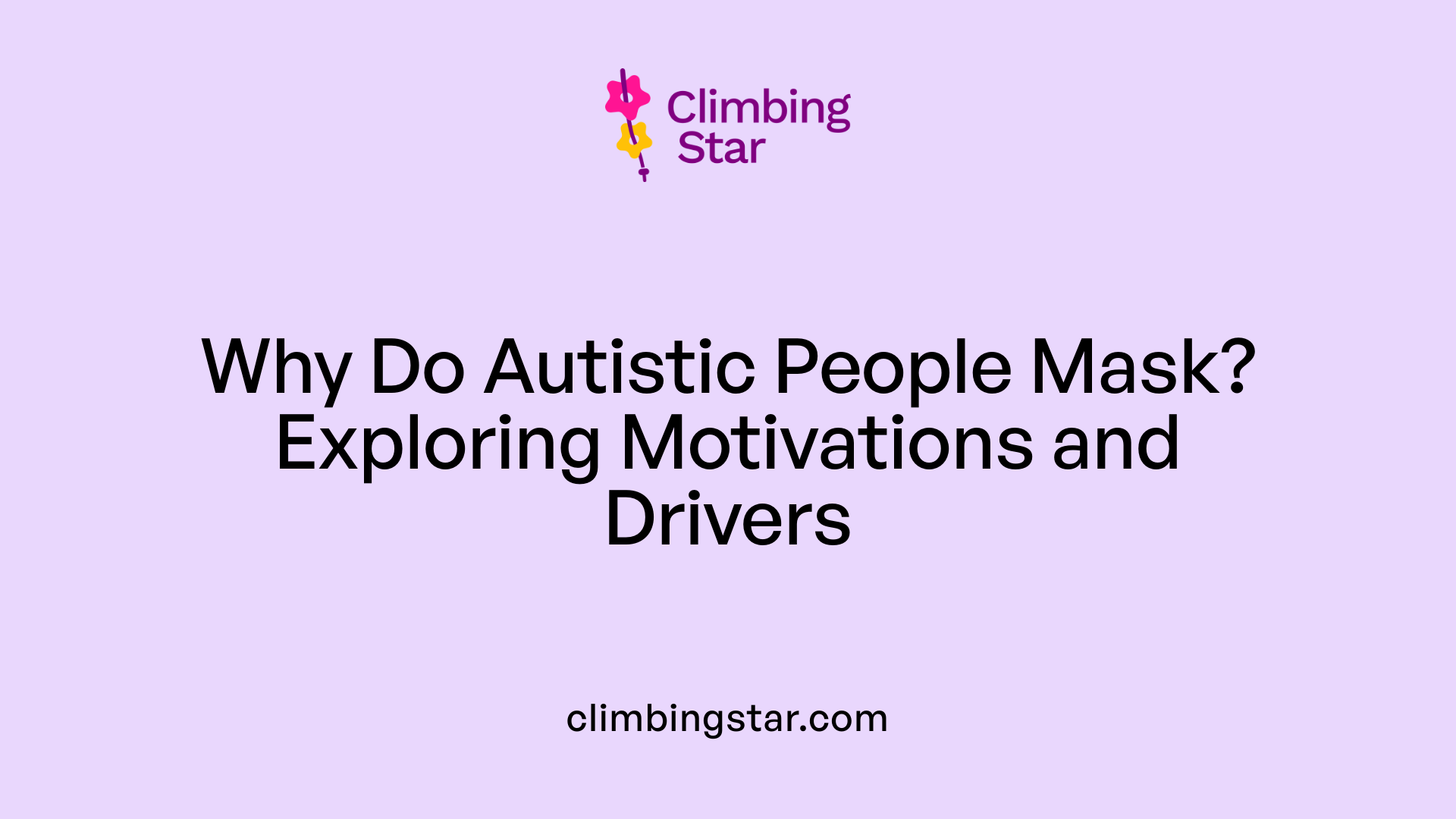
What are the reasons and motivations behind autism masking?
Autism masking, also known as camouflaging, is driven primarily by the desire for social acceptance and safety. Many autistic individuals develop masking behaviors to blend in with neurotypical peers, seeking to avoid negative reactions such as stigma, prejudice, and bullying. This effort to appear 'normal' helps them navigate social environments like school, work, or social gatherings where differences may attract unwanted attention.
One common motivation is the need to fit into societal expectations. Autistic people often mask to meet the behavioral norms of their surroundings, suppressing natural responses like stimming, which might be seen as unusual or unacceptable. They may also hide sensory sensitivities, experiencing loud noises or bright lights without expressing discomfort to avoid judgment.
Gender and age significantly influence masking tendencies. Women and girls, for example, are more likely to mask due to social conditioning and stereotypes around femininity and social harmony. Adolescents and young adults often mask to gain peer acceptance, while some adults with late diagnoses continue masking to maintain employment or social relationships.
Masking can serve as a temporary boost in confidence. By mimicking social cues, rehearsing conversations, and controlling their behaviors, individuals often feel more capable of engaging socially. However, this is usually exhausting over time. Persistent masking requires significant mental effort and can lead to serious issues like emotional burnout, depression, and a sense of losing one's authentic identity.
Despite these challenges, many navigate masking to protect themselves from potential harm and to secure their place in social or professional settings. Yet, this long-term reliance can obscure the visibility of autistic traits, sometimes delaying diagnosis and access to support. Increasing societal acceptance of neurodiversity and fostering inclusive environments can reduce the pressure to mask, improving mental health and enabling autistic individuals to express their true selves.
Impacts and Consequences of Masking on Mental Health
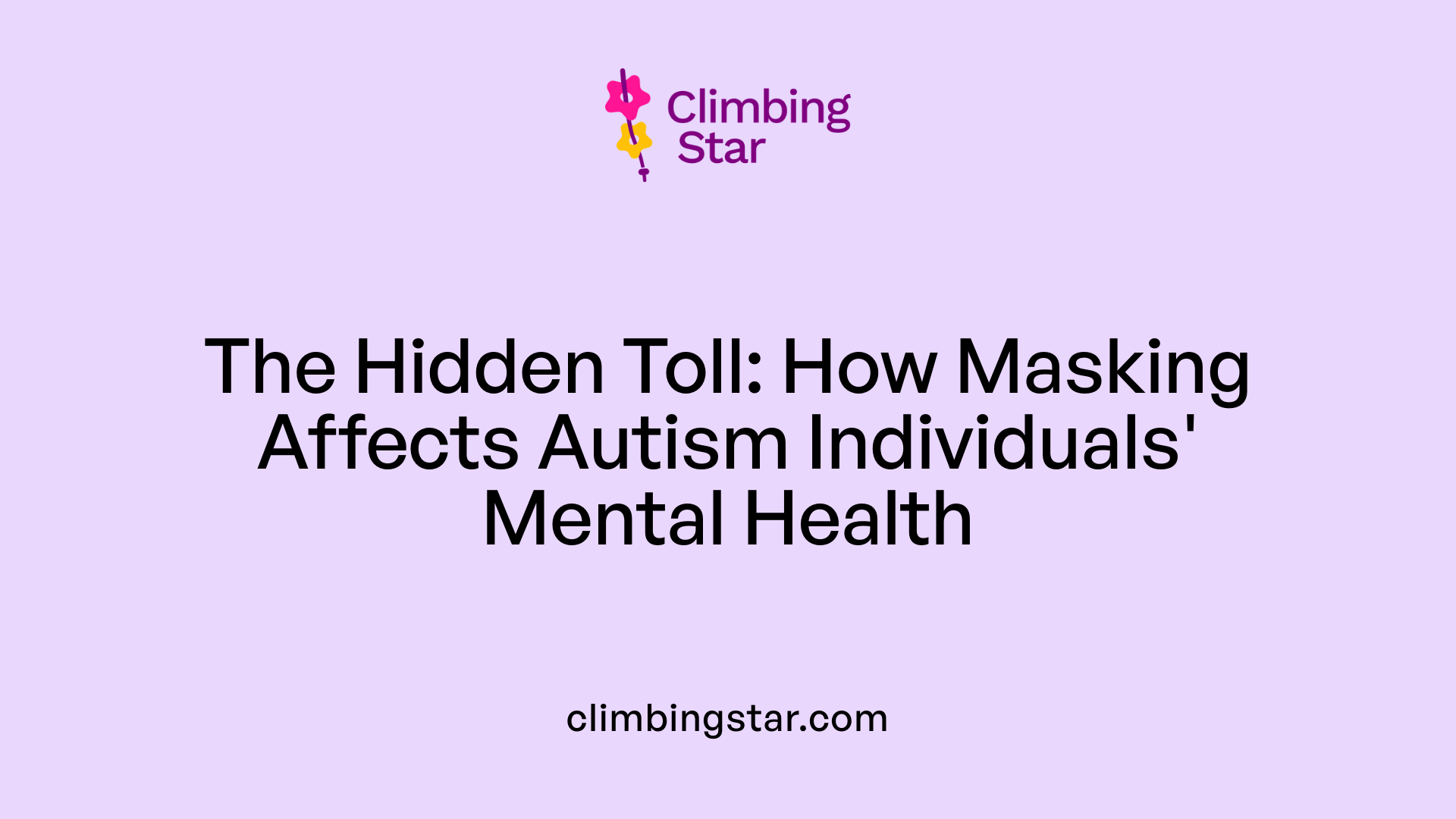
What are the effects and implications of autism masking on individuals?
Autistic masking involves concealing or suppressing autistic traits to appear more neurotypical. Many individuals do this consciously or unconsciously, motivated by societal stigma, past negative experiences, or the desire for social acceptance and safety. Masking behaviors include practices such as avoiding reactions to sensory sensitivities, mimicking social cues, scripting responses, and hiding interests or behaviors like stimming.
While masking can initially help individuals blend in better in social environments like school, work, or gatherings, it carries significant long-term mental health costs. The continual effort required to maintain these masks often leads to extensive mental and physical exhaustion. Burnout is common among those who mask extensively, resulting in feelings of being drained and overwhelmed.
Moreover, prolonged masking can intensify feelings of anxiety and depression. Many autistic people report experiencing a disconnection from their true selves, feeling like they are living behind a facade. This disconnection can cause a loss of identity, leading to emotional distress, social withdrawal, and feelings of loneliness.
A concerning implication of masking is its impact on diagnosis and support. Because masking can hide core autistic traits, individuals often go undiagnosed or are diagnosed late. This delay can deny them access to specialized resources, therapies, and understanding they need to thrive. Masking also complicates efforts to provide appropriate mental health support, as clinicians may struggle to see the full picture of an individual's experiences.
Long-term, sustained masking is associated with increased vulnerability to serious mental health issues, including suicidal ideation. The emotional toll of constantly hiding one's true self can foster hopelessness, low self-esteem, and self-criticism.
How can masking influence mental and physical exhaustion, burnout, and fatigue?
Masking requires continuous monitoring of one's behaviors and responses, which can be intellectually and emotionally draining. Over time, this persistent effort can lead to burnout—a state of complete physical and emotional exhaustion. Individuals may feel overwhelmed by the effort to sustain their masks, especially in high-pressure environments or when they face ongoing societal intolerance.
Physical symptoms can include fatigue, headaches, and sensory overload, especially in individuals with heightened sensitivities. The mental strain of maintaining social scripts and suppressing natural behaviors adds to this exhaustion, often culminating in shutdowns or meltdowns as an uncontrollable response to stress.
What are the social and emotional consequences of disconnection from authentic self and social withdrawal?
Many autistic individuals describe masking as creating a barrier between their true selves and the outside world. This disconnection can erode self-esteem and make social interactions feel superficial or exhausting.
Social withdrawal may occur as a protective response to avoid the emotional toll of masking and potential rejection. Over time, this can lead to heightened feelings of loneliness, diminished social skills, and a reluctance to engage in future social opportunities.
How does masking increase vulnerability to mental health problems and suicidality?
The persistent effort to hide one's true neurodivergent traits often results in emotional suppression and stress. These factors significantly raise the risk of developing mental health disorders like anxiety, depression, and post-traumatic stress.
Studies indicate that autistic individuals who mask extensively are at higher risk of suicidal ideation. Feelings of shame, shame about their true identities, and the fear of being judged or rejected fuel hopelessness and despair.
How does masking lead to delayed diagnosis and support barriers?
Because masking conceals autistic traits, it can make recognition by friends, family, and professionals more difficult. Especially in women and girls, whose autistic traits may be less overt or differently expressed, masking can result in late diagnoses or misdiagnoses.
This delay prevents access to tailored support, interventions, and accommodations. Without proper understanding, autistic individuals may continue to struggle silently, increasing their risk for mental health issues.
What are long-term psychological effects of extended masking?
Extended masking can have profound psychological impacts. It often leads to a diminished sense of authenticity, increased emotional burnout, and identity confusion. Many experience low self-esteem and internalized shame.
Psychologically, sustaining masks over many years can foster feelings of disconnection from oneself and others. This disconnection may contribute to chronic depression, anxiety, and sometimes suicidal thoughts.
Addressing these effects involves understanding the importance of authentic self-expression, providing supportive environments, and promoting societal acceptance of neurodiversity. Recognizing the toll of masking and supporting unmasking efforts can greatly improve mental health and overall well-being of autistic individuals.
| Impact Area | Description | Examples / Details |
|---|---|---|
| Mental and physical exhaustion | Continuous effort to maintain masking behaviors leads to fatigue and burnout. | Headaches, fatigue, sensory overload, shutdowns. |
| Anxiety, depression, and identity issues | Masking contributes to feelings of disconnection and emotional distress. | Increased risk of suicidal ideation and low self-esteem. |
| Disconnection from authentic self | Masking creates a barrier between true identity and outward presentation. | Feelings of inauthenticity, social withdrawal. |
| Support barriers and delayed diagnosis | Concealed traits hinder recognition and access to support. | Late diagnosis especially in women, misdiagnosis. |
| Long-term effects | Prolonged masking can cause deep psychological impacts. | Chronic depression, identity confusion, emotional exhaustion. |
Understanding these impacts emphasizes the importance of creating more accepting environments where autistic individuals can feel safe to be themselves without the burden of constant masking.
Recognizing and Measuring Masking Behaviors
How can autism masking be identified and measured?
Autism masking is often complex to recognize because it involves subtle behaviors and internal experiences. One of the primary ways to identify masking is through observing discrepancies between outward behaviors and an individual's internal state. For instance, a person might appear confident and socially engaged but may be suppressing natural autistic responses such as stimming or avoiding eye contact.
External signs of masking include behaviors like suppressing stimming, pretending to follow social conversations, mirroring others’ facial expressions, adjusting speech tone and volume, and using rehearsed phrases or scripts. These actions are often driven by the desire to fit societal norms and avoid judgment.
Internally, masking can be felt through the effort and exhaustion it requires. Many autistic individuals report feeling drained, anxious, or emotionally exhausted after social interactions where they have had to mask their traits. This mental effort can lead to burnout, emotional shutdowns, or meltdowns, which are often misinterpreted or overlooked.
To systematically measure masking behaviors, researchers and clinicians utilize specific tools like the Camouflaging Autistic Traits Questionnaire (CAT-Q). The CAT-Q is a validated self-report instrument designed to quantify masking across three domains:
| Sub-Scale | Description | Example Behaviors |
|---|---|---|
| Compensation | Strategies used to compensate for difficulties | Mimicking social cues, rehearsing responses |
| Masking | Hiding traits or avoiding displaying certain behaviors | Suppressing stimming, avoiding certain interests |
| Assimilation | Blending in with neurotypical peers | Copying social behaviors, adopting social norms |
This questionnaire helps distinguish levels and types of camouflaging strategies, providing insight into how individuals adapt to social environments.
In addition to self-report tools, behavioral observation is crucial. Clinicians observe subtle cues like difficulty maintaining natural eye contact, effortful speech, or repetitive motions that are being consciously hidden. Combining these observations with self-report responses enables a more comprehensive assessment.
Challenges in diagnosis due to masking
Masking often complicates diagnosis, especially in groups like women or gender-diverse individuals. Because masking hides typical autistic traits, it can delay recognition of autism or lead to misdiagnosis. Some individuals might be diagnosed late or not at all if their outward behaviors appear neurotypical.
Moreover, under-reporting of masking behaviors can happen if individuals are unaware of how much effort they put into hiding their traits or if they are reluctant to admit to masking due to stigma.
In summary, effective recognition and measurement of masking require an integrated approach. Observing external behaviors, understanding internal effort, employing tools like the CAT-Q, and maintaining clinical sensitivity are all vital. Improving awareness of masking helps create better support systems, accurate diagnoses, and more accepting environments.
By understanding these behaviors and using systematic tools, clinicians and support networks can better identify when masking occurs and address the underlying needs of autistic individuals.
Impact of Masking on Mental and Emotional Well-being
What is the impact of autism masking on mental health and well-being?
Autistic masking, also known as camouflaging, can have profound and often negative effects on mental health. While it is sometimes used as a coping mechanism to fit into society, the long-term consequences can be detrimental.
One of the most significant impacts is the increase in anxiety and depression. Constantly monitoring and adjusting behaviors to appear neurotypical requires immense mental effort. This hyper-vigilance can lead to heightened stress levels and feelings of emotional exhaustion.
Masking often causes a disconnection from the individual's true self. Many autistic people report feeling like they are living a false personality, which can lead to identity issues. Over time, this loss of authentic expression might diminish self-esteem and create feelings of shame or worthlessness.
Burnout is another serious concern. Prolonged masking can deplete energy reserves, resulting in fatigue and emotional breakdowns. This state of exhaustion is sometimes referred to as autistic burnout, where the individual feels physically, emotionally, and mentally drained.
The strain of masking also leaves individuals more vulnerable to mental health crises, including suicidal thoughts. The persistent effort to hide autistic traits and the resulting emotional toll can contribute to feelings of despair and hopelessness.
Furthermore, masking can increase the risk of experiencing discrimination and harm. Because masking often conceals the signs of autism, individuals may not receive necessary support or accommodations. This invisibility can lead to misunderstandings, stereotyping, or even abuse.
Understanding these impacts underscores the importance of fostering a supportive environment. Recognizing that masking, while sometimes necessary for short-term social acceptance, carries significant emotional costs is vital.
Supporting autistic people involves accepting their authentic selves, reducing societal pressures, and promoting understanding. Creating inclusive spaces where individuals feel safe to be themselves can decrease the need to mask and improve overall mental health.
Research indicates that understanding the effects of masking can guide better mental health interventions. Tools like the Camouflaging Autistic Traits Questionnaire (CAT-Q) have been developed to measure masking behaviors, emphasizing the importance of acknowledging and addressing these hidden struggles.
In summary, while masking may help autistic individuals navigate social situations temporarily, it often results in increased anxiety, depression, emotional exhaustion, identity issues, burnout, and heightened vulnerability to discrimination. Supporting authenticity and evolving societal attitudes are crucial steps toward enhancing the well-being of autistic individuals.
Supporting Unmasking and Creating Inclusive Environments
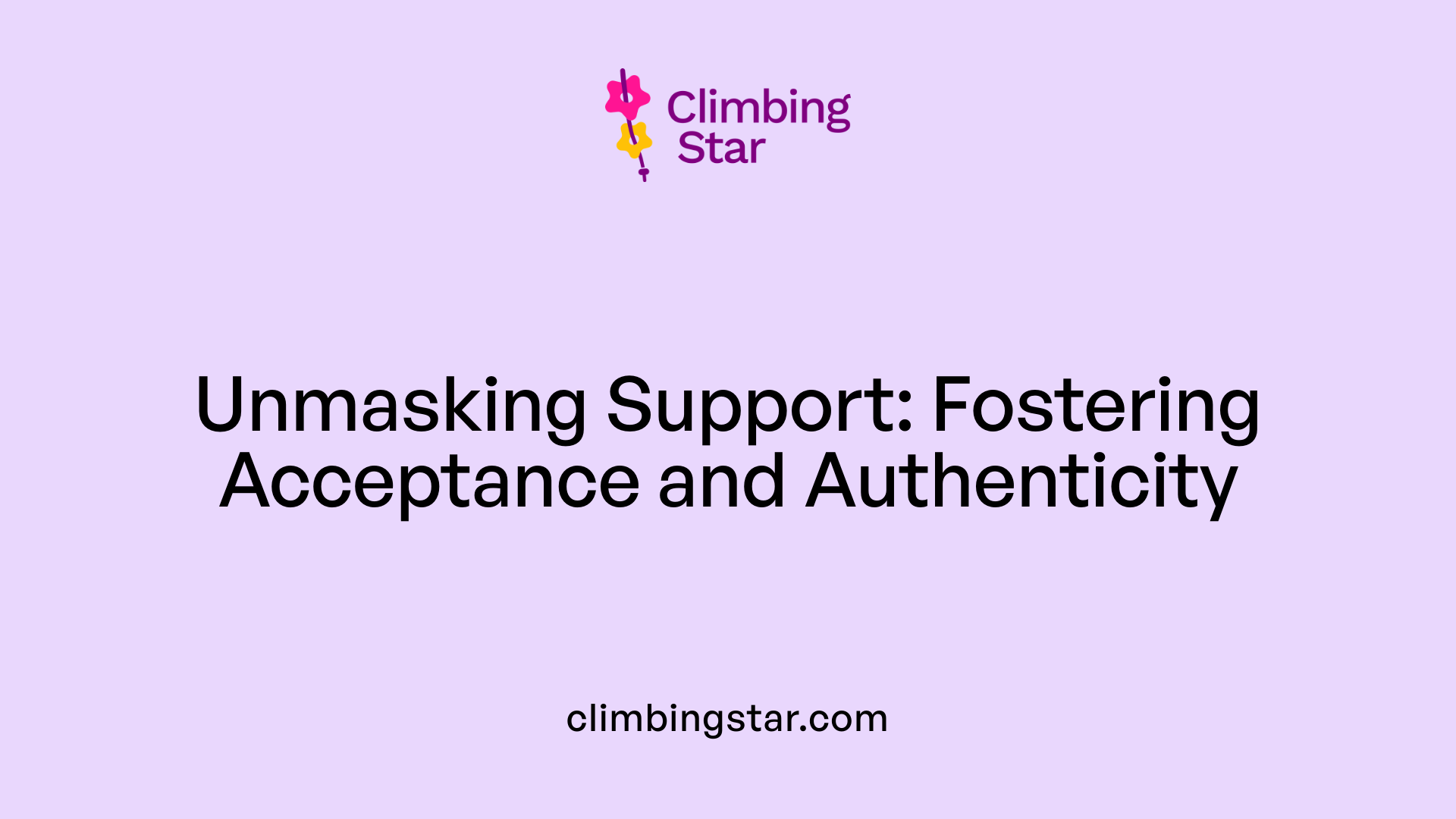
What strategies exist for unmasking and supporting autistic individuals who mask?
Supporting autistic individuals in unmasking is a delicate process that emphasizes safety, understanding, and gradual steps. Creating environments where they feel accepted and free from judgment is fundamental. These spaces might include supportive communities—both online and offline—where authenticity is encouraged and celebrated.
Encouraging self-awareness is a vital step. This involves helping individuals recognize behaviors they use to mask and exploring their genuine interests and responses. For some, this may mean engaging in activities that they have previously hidden or suppressed.
Professional support from therapists or counselors experienced in autism can facilitate this process. Such specialists can guide individuals through strategies to safely unmask—often starting with small, controlled disclosures—and help address issues like internalized ableism or societal pressure.
Joining peer or community groups composed of neurodivergent members can also be empowering. These spaces provide shared understanding, validation, and the opportunity to observe others' experiences with unmasking.
Patience is essential because unmasking can be emotionally taxing. Respecting personal timing and boundaries ensures that individuals feel in control of their journey. Societal change also plays a critical role; increased acceptance and accommodations can reduce the need for masking altogether.
Overall, the goal is to support individuals in expressing their authentic selves at their own pace, fostering self-acceptance, and advocating for broader societal understanding.
Role of self-awareness, therapy, and community support
Self-awareness helps individuals identify their masking behaviors and understand why they engage in them. Therapy can provide tools to process these insights safely, addressing underlying issues like anxiety or low self-esteem.
Community support—whether through neurodiverse groups, online forums, or social circles—offers validation and shared experiences. These groups often create a sense of belonging that encourages openness.
Together, self-awareness, professional guidance, and community involvement form a strong foundation for unmasking, enabling individuals to regain confidence and reconnect with their true selves.
Societal changes: acceptance, accommodations, neurodiversity
Creating a society that accepts neurodiversity reduces the pressure to mask. This involves changing social attitudes, policies, and workplace practices to be more inclusive.
Implementing accommodations—such as quiet workspaces, flexible schedules, or sensory-friendly environments—allows autistic individuals to thrive without feeling the need to hide their traits.
Embracing neurodiversity shifts the narrative from viewing autistic traits as deficits to recognizing them as natural variations of human experience. This fosters a culture of respect and understanding.
Educational programs and training for employers, teachers, and the public can promote acceptance and reduce stigma, making unmasking a less risky or exhausting endeavor.
Importance of educating the public and reducing stigma
Public education campaigns can increase awareness about autism and the reasons behind masking. Understanding that masking often stems from societal pressures and fear of discrimination can inspire empathy.
Reducing stigma involves challenging stereotypes and advocating for acceptance of diverse ways of thinking and behaving. Media representation and inclusive narratives play a role in this effort.
Awareness and education empower autistic individuals to express their true selves and seek support without shame or fear.
Supporting individuals in expressing their true selves
Supporting authentic expression involves listening without judgment, respecting personal boundaries, and providing affirming environments.
Encouraging self-advocacy and celebrating small steps toward authenticity can build confidence.
Teachers, employers, and peers can facilitate this by creating adaptable, understanding spaces where different behaviors and ways of communicating are accepted.
Overall, fostering a societal culture that values neurodiversity and individual differences diminishes the need for masking, promoting well-being and genuine connection for autistic individuals.
The Role of Society and Future Research
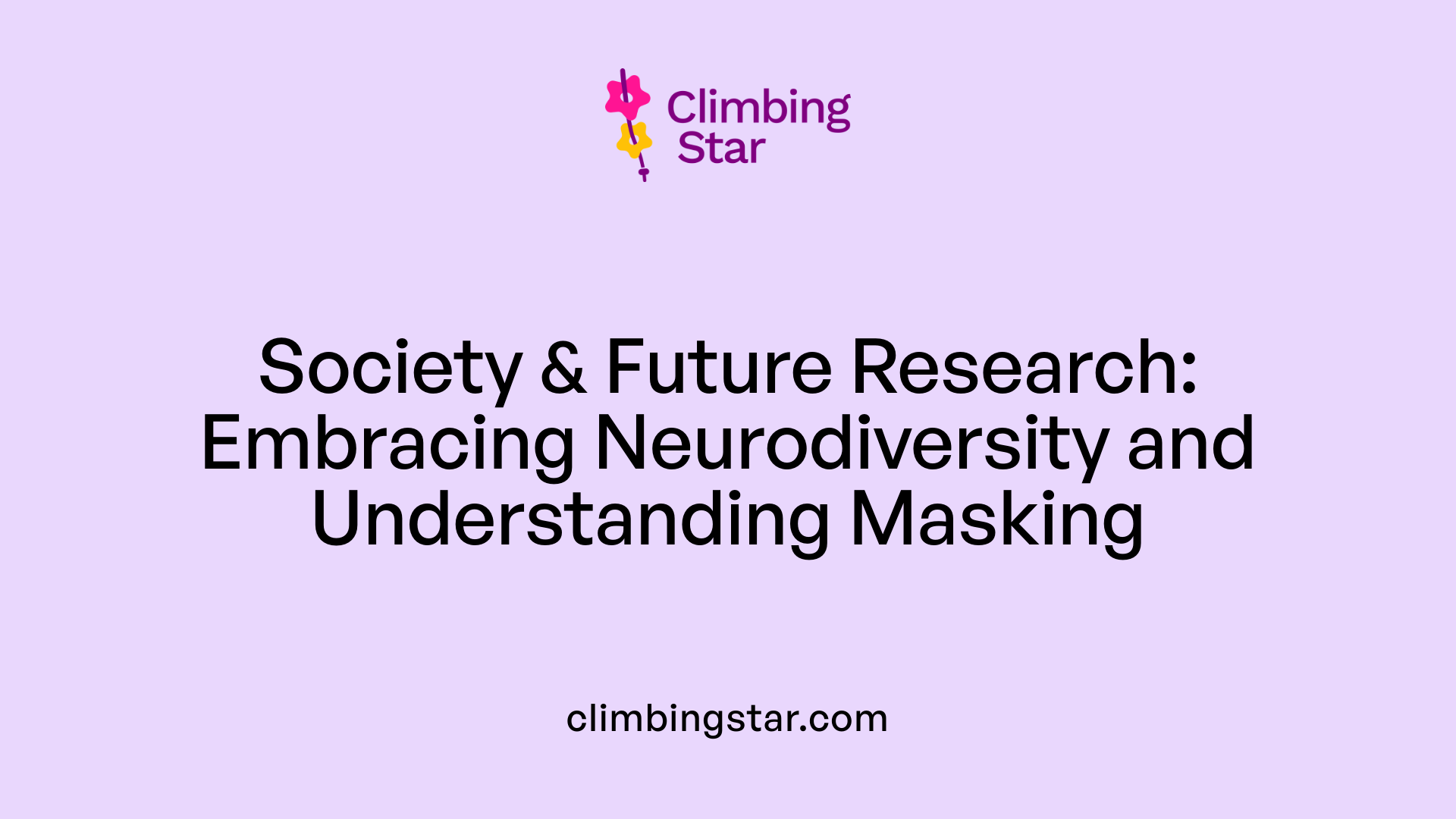
How do societal and social factors influence autism masking?
Societal and social influences play a significant role in shaping masking behaviors among autistic individuals. These factors create environments where hiding or modifying authentic behaviors becomes a necessary response to societal pressures. For example, persistent stigma surrounding autism and neurodiversity fosters an environment where openly displaying autistic traits—such as stimming or difficulty maintaining eye contact—may lead to judgment, social rejection, or discrimination.
Norms and expectations rooted in ableism promote the idea that neurotypical behaviors are the standard of acceptable social conduct. As a result, autistic people often feel compelled to imitate neurotypical social cues, suppress natural responses, and develop coping strategies like scripting conversations and hiding interests. This societal pressure varies across different contexts, such as schools, workplaces, or social gatherings, further driving the need to mask.
Cultural attitudes influence the extent and manner of masking, with some communities encouraging conformity more than others. Limited awareness and misconceptions about autism compound this issue, making it difficult for autistic individuals to express their genuine selves without fearing negative repercussions.
In addition, systemic ableism can lead individuals to mask to access opportunities or avoid exclusion. This constant effort to conform affects mental health, identity development, and the quality of social interactions, often resulting in exhaustion and feelings of disconnection from one’s true self.
What is current research and what are future directions regarding autism masking?
Research into autism masking is rapidly evolving, aiming to better understand its prevalence, the mechanisms involved, and its psychological consequences. Current studies focus on how masking behaviors manifest across different populations, especially among women, nonbinary individuals, and marginalized groups like BIPOC (Black, Indigenous, and People of Color). Using tools like the Camouflaging Autistic Traits Questionnaire (CAT-Q), researchers quantify masking levels, exploring subdomains such as compensation, masking, and assimilation.
Many studies recognize that masking is a complex interplay of conscious decisions and subconscious adaptations. Researchers examine factors such as gender norms, societal expectations, and intersectional identities that influence the extent and style of masking. The double empathy problem, which describes mutual misunderstandings between autistic and non-autistic people, is also pertinent in understanding social masking.
Looking ahead, future research aims to develop more objective and standardized assessment tools, moving beyond self-reporting limitations. Longitudinal studies are planned to explore how masking develops and changes over a person’s lifespan, including its roots in early childhood and persistence into adulthood.
A key goal is to understand how masking intersects with trauma, internalized ableism, and mental health issues such as burnout, depression, and suicidality. Exploring therapeutic interventions that support unmasking in safe environments is also a focus. Creating inclusive spaces that reduce societal pressures for conformity can lessen the need for masking, improve well-being, and foster genuine connections.
Advancing understanding of masking as a social and multidimensional process will ultimately enhance diagnosis accuracy, refine support strategies, and promote societal acceptance of neurodiversity.
| Aspect | Current Focus | Future Directions | Details |
|---|---|---|---|
| Research Scope | Prevalence, mechanisms, impacts | Development of reliable assessment tools | CAT-Q and other measures, lifespan studies |
| Populations Studied | Gender differences, marginalized groups | Broader demographic and cultural studies | BIPOC, nonbinary, diverse cultural contexts |
| Psychological Focus | Burnout, identity, mental health | Trauma links, internalized ableism | Long-term mental health effects |
| Intervention Development | Support strategies for masking reduction | Creating accommodating social environments | Therapy, societal change, inclusive practices |
| Societal Impact | Raising awareness, reducing stigma | Education, policy, societal acceptance | Media campaigns, policy reforms |
Understanding how societal influences mold masking and driving research to uncover its complexities provides hope for better support systems and a more accepting society that embraces neurodiversity.
Moving Towards Acceptance and Understanding
As awareness grows and societal perceptions evolve, there is hope for a future where autistic individuals can be authentic without fear of judgment or discrimination. Reducing the need for masking involves promoting neurodiversity, fostering inclusive environments, and challenging harmful stereotypes. Supporting unmasking efforts through education, acceptance, and tailored support can improve mental health and quality of life for autistic people. Emphasizing societal change and individual understanding will help bridge gaps, ensure better diagnosis, and honor the diverse ways of being that define the neurodiverse community. Ultimately, recognizing and respecting the authentic selves of autistic individuals is key to building a more compassionate and inclusive society.
References
- Masking
- Autistic masking
- Autism Masking Is Common. Here's How To Recognize ...
- “Masking” in Individuals with Autism Spectrum Disorder
- A Conceptual Analysis of Autistic Masking: Understanding ...
- Masking: A Guide
- What are the main signs of autism masking in women?
- Masking when you're autistic | Autism Space
- Understanding Masking: A Neurodiversity-Affirming ...







